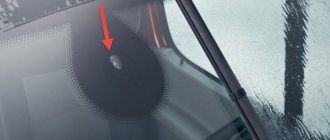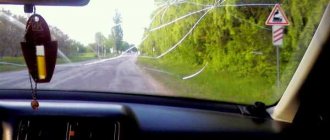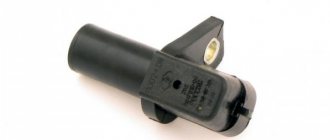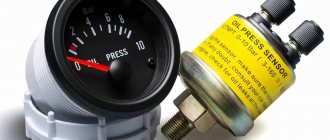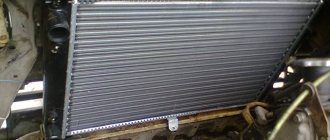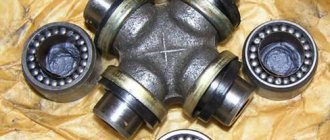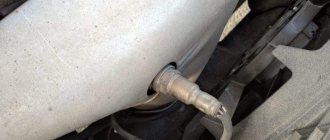The rain sensor in the car is responsible for automatically turning on the windshield wipers when there is precipitation. On models equipped with power windows and/or a power sunroof, it can additionally command them to close. If the sensor fails, false alarms of the windshield wipers and power windows, or auto mode may be disabled.
In this article we will tell you how to find out if there is a rain sensor in your car and whether you can install it yourself if you don’t have one, how to check the rain sensor and troubleshoot it.
How does a rain sensor work?
Structurally, the rain sensor consists of an infrared light emitter and a sensor that registers its reflection. The device body is mounted on the windshield. To find out if your car has a rain sensor, just look if there is a small block with a “window” behind the interior mirror mount, and if there is an AUTO mode on the windshield wiper control lever .
The operating principle of a rain sensor on a car is as follows:
- The emitter in pulse mode generates light waves passing through the windshield.
- Part of the IR radiation is reflected from the refractive point (glass and air) and hits the sensor that captures these rays (photodiode).
- The sensor controller is configured in such a way that it does not respond to a signal reflected from clean glass.
- When a foreign substance (water drops, dirt, etc.) gets on the glass, the refractive index of the media boundary and the number of reflected IR rays change.
- By detecting a change in the sensor signal, the controller activates the windshield wipers, closes the windows and sunroof, etc. Depending on the magnitude of the signal deviation from the norm, the speed of movement of the brushes can be adjusted: the more wet or dirty the wipers are, the faster they work.
- When the signal from the IR sensor returns to normal, the controller turns off the wipers.
In new models, the rain sensor is often combined with a light sensor. This is achieved by adding sensors to the unit that detect visible and ultraviolet radiation.
Is it possible to install a rain sensor yourself?
Do-it-yourself installation of a rain sensor on Kalina: video
Budget models are usually equipped with a rain sensor only in luxury trim levels. You can install it for an additional fee as an option, at a service station or yourself. When installing a standard sensor, you may need not only a connection to the power supply, but also software activation using a diagnostic scanner.
A rain sensor can also be installed on old or budget cars (VAZ, Kia, Hyundai), which do not provide this function at all. For such cases, simple and inexpensive DDA sensors (Automotive Rain Sensor, manufactured in Togliatti) are suitable, which are connected instead of the standard windshield wiper relay or attached to the wiper control lever block. The sensor is activated when intermittent mode is turned on, adjusting the speed of the brushes depending on the intensity of precipitation.
The connection method and diagram, as well as the type of compatible sensor (DDA-15, DDA-25, etc.) directly depend on the specific car model. For example, for the Hyundai Creta, as well as other Hyundai and Kia models, in which the operation of the windshield wipers is controlled through a separate wire, the DDA-70 sensor is suitable. The pinout of the RS-22 rain sensor for the VAZ is shown in the illustration below.
The general principle of installing such a sensor to the car wiring is as follows:
- the ground wire (in this case blue) is connected to the body;
- the power supply (red) and output (yellow) wires are connected to the operation break of the switch wire that controls the wiper relay;
- the control wire (black) is connected to the wire responsible for the intermittent wiper operation (usually 0 V when the blades are parked and +12 V when driving).
If you cannot figure out the wiring pinout yourself, it is better to trust a qualified electrician who specializes in your brand of car.
As a rule, a rain sensor cannot be installed on athermal (isothermal) glass without a standard “window” under it, because such glass absorbs IR radiation.
Principle of operation
Any transition between substances in contact forms an optical boundary. All types of electromagnetic radiation are refracted on it, that is, they change the angle of propagation and energy properties. Part of the beam passes through the boundary, while the other is reflected and returned to an optically denser substance.
For example, fiber-optic communication lines operate on this principle, where at a certain angle light cannot escape the glass and spreads over long distances without loss.
The most suitable frequency range turned out to be infrared (IR) radiation. Its spectrum lies below the limit of visible light. Such radiation is felt only as heat, and therefore is considered thermal; the eye does not notice it. However, this is a wave with properties close to light, and therefore works according to optical laws.
Why doesn't the rain sensor work?
The rain sensor itself is a simple and reliable device. Its failures and incorrect operation are most often associated with the windshield or control electronics. Replacing the sensor may only be necessary in the event of physical damage or failure of the controller due to a voltage drop in the on-board network.
The most likely reasons why the rain sensor stops working are listed in the table.
| Cause of sensor malfunction | When does this occur? | Why does the device not work and how to fix it? |
| There are films or coatings on the glass or insufficient lighting | Grease spots on the windshield | Sprays on the glass change the refractive index, thereby interfering with the operation of the sensor. To fix the problem, you need to clean the glass using windshield washer or alcohol. The sticker or film covering the sensor must be removed. |
| Chemical stains after washing | ||
| Poorly selected anti-rain liquid | ||
| Tint film applied to glass | ||
| Sensor overheating | Heated windshield switched on in warm weather | When the temperature rises, the sensor transmits incorrect readings to the controller. You can correct the situation by turning off the heated glass, changing the direction of the air flow of the stove, or moving the sensor (this option is suitable for non-standard ones). |
| Heater air ducts directed at the glass in warm weather or when parked | ||
| Damaged wiring or fuse | Oxidation of contacts due to moisture | If there is no power, the sensor will not work. To fix the problem, you need to find the location of the damage and restore the wiring or fuse. |
| Loss of contact due to vibration | ||
| Short circuit in the circuit | ||
| Voltage surge in the on-board network | ||
| Wire damage | ||
| Windshield icing | Sudden temperature change | When the glass freezes, the rain sensor does not work correctly due to a change in the refractive index. To eliminate the problem, defrost the glass by increasing the heating intensity or remove the ice mechanically. |
| Heating disabled | ||
| Lack of warm air when driving at high speed in severe frost | ||
| Glass damage | Entry of foreign objects | Glass defects in the area of the rain sensor change the refractive index, and the amount of light reflected onto the sensor changes. For minor abrasions and minor scratches, the windshield in the area of the sensor window needs to be polished. If the damage is significant, it must be replaced with a new one. |
| Natural wear due to brush operation | ||
| Sensor detachment | Windshield overheating | If the sensor loses contact with the glass, its signal is distorted. To fix the problem, you need to re-glue the sensor using transparent adhesive recommended by the manufacturer. The use of some adhesives and sealants changes the refractive index, which may cause the rain sensor to not function properly. |
| Contact of aggressive liquids (such as solvent) inside the windshield | ||
| Vibrations, car shaking | ||
| Getting into an accident | ||
| Sensor failure or controller malfunction | Sensor overheating | If the voltage in the car's electrical system suddenly goes beyond the permissible limits, or the car is subjected to impacts, the rain sensor or its controller may fail. In this case, the faulty element will have to be replaced. |
| Voltage surge in the on-board network | ||
| Abrupt power loss | ||
| Getting into an accident | ||
| Violation of calibrations | Power failure | A rain sensor error can occur due to a sudden loss or surge in the supply voltage, interference in the operation of the electronics (flashing, adding/removing blocks, etc.). If the sensor becomes untied, it needs to be reinitialized in the system and possibly calibrated. |
| Power surge | ||
| Interventions in the ECU or BC firmware | ||
| Reconnecting or replacing the sensor | ||
| Incorrect sensor model | Replacing the sensor | If the rain sensor stops working after replacing the windshield assembly or the sensor itself, the reason may be due to incompatibility with the model. Sensors that are identical in appearance and used on vehicles of different years of manufacture or configurations may differ in pinout, output signal shape, or other parameters. Sometimes solving the problem is possible programmatically, through firmware in the ECU of the corresponding sensor model, but often it requires replacing it with a compatible one. |
| Windshield replacement |
To prevent the rain sensor from malfunctioning, you need to keep the car clean, use good windshield washer fluid, and avoid excessive wear on the wiper blades so that they do not rub the glass. For the same reason, you should not drive with an empty washer reservoir, wiping the glass “dry”. The main reason for the incorrect functioning of the sensor in winter is icing of the glass. It can be prevented by applying special anti-icing agents or adjusting the heating operation.
It is forbidden to pour boiling water over the glass or subject it to local heating for rapid thawing! Temperature changes can cause cracking of triplex layers due to uneven expansion.
If the rain sensor activates spontaneously at the car wash, make sure that the car's ignition is turned off and the key is removed from the lock. If the problem persists, you should look for problems with the wiring and/or electronics.
Nuances of operation
When using this device, it is important to know about some features. Remember that no mechanism can be perfect.
The rain sensor should only be positioned vertically. It is placed in the part of the glass where the wipers reach. The glass at the installation site must be perfect - no chips or deformations.
If an infrared filter is installed on the glass, it can become a serious obstacle to the operation of the anti-rain device.
Most models function only in the first wiper position. Then they successfully coordinate the intensity of the windshield wipers. In other positions, the device cannot affect their operation.
The sensor is not able to fully control the windshield wipers. Sometimes local contamination of the windshield occurs due to splashes from a puddle or bird droppings. If the sensor does not see this, the windshield wipers will not turn on. This means that the driver should “help” the device and not shift all responsibilities to the sensor. In dry weather, the device should be turned off so that the wipers do not scratch the glass without liquid. Here's what can cause the device to suddenly work:
- spray;
- insects;
- leaves;
- fluff;
- shade from trees.
Reference. Rain sensors are used not only in private cars, but also during field work. They control irrigation systems, regulating the volume of water supplied.
How to check the functionality of the rain sensor
Checking the rain sensor for functionality: video
Before checking the rain sensor on your car for functionality, you need to clean the windshield in the area where it is located using an alcohol solution or a non-aggressive solvent.
The product will remove greasy films and other chemical contaminants that may not be noticeable and cannot be washed off with clean water. It is also worth checking the security of the sensor.
To check the rain sensor you will need a multimeter, a diagnostic scanner, and a spray bottle of water.
How to check a rain sensor: instructions
- Turning on the sensor .
Turn on the ignition, activate the automatic start of the wipers using the steering column switch and spray water into the sensor area on the glass. After this, the windshield wipers should work. On some cars (in particular, VAG), automatic activation of the windshield wipers based on a signal from the rain sensor is possible only after reaching a certain speed (for example, 16 km/h)! - Setting the mode . The windshield wiper switch usually has an additional washer to adjust the sensitivity of the sensor. First you need to set the highest level. If in this mode the sensor works, but only with large quantities of water, the problem may be a violation of the calibrations.
- Checking sensor data. The best way to check the functionality of the rain sensor is to read ECU errors using an on-board computer or a diagnostic scanner. There are no universal codes for this malfunction; each manufacturer uses its own.
You can check the operation of the emitter by pointing it at the sensor from outside phone camera.
Digital matrices, unlike the human eye, see part of the infrared range, but not all. Therefore, the method is only suitable for sensors emitting at short waves
.In modern cars, on-board systems are controlled by digital signals; checking the rain sensor with a multimeter in most cases will not give results. With its help, you can only check the fact of the presence of a signal. To check the correct operation, you need to take an oscillogram of the signal and compare it with normal indicators taken from a known-good sensor.
- Checking the signal supply . The sensor may be working, but it will not send a signal to turn on the wipers. In this case, first of all you need to check the fuse and the windshield wiper relay. Having found the car wiring diagrams, you should check the voltage at the wiper relay terminals. If, when water enters the sensor area, 12 V is supplied to the control contact, the sensor itself, its controller and switch are working properly, and the problem is in the connection of the wiper motor or its wiring. If there is no control signal, but the windshield wipers operate directly (when forced on or when power is supplied to the power contact), faults must be looked for in the sensor, its wiring or the switch.
The rain sensor may not work if this function is not activated.
Test and setup
To make sure that the system is working properly, you need to switch the wipers to the first position. After this, you need to pour (preferably from a spray bottle) a small amount of water onto the glass. The DD should immediately activate the brushes, which will begin to work more intensely at first, and then they will slow down and stop as water is removed from the windshield. If the driver is not satisfied with the result, then it is enough to adjust the operating mode of the sensor (all settings are specified in the instructions).
However, even if the motor works like a clock, you must always have access to manual control of the brushes. For example, if a flying bird “left a surprise” in the form of droppings on the windshield, then the automatic system may not work.
It is also worth considering the possibility that the DD (if it has a mode for reading the number of drops) will begin to trigger from midges that fall on the glass. Therefore, in dry weather it is recommended to turn it off. It is best to choose a device based on the make of your car.
How to activate the rain sensor
Activating a rain sensor through the Vasya-diagnostic program: video
Normal activation of the rain sensor is carried out using the steering column switch. To do this, you need to move it up and select the sensitivity of the sensor using the ring or “checkbox”. After this, the wipers should automatically turn on when water hits the glass.
On a number of cars, the operation of the sensor is configured through the menu of the head unit or on the dashboard. The operation is controlled by the option of the same name (Rain Sensor in English), which must be switched to the “on” or “on” position.
In some cases (voltage surge, disconnection of the battery terminal, interference with the ECU firmware), the sensor may “unbind” and requires its activation to rebind. Sometimes it also happens that the corresponding options were installed at the factory, but are not activated in the firmware. Similar cases occur, for example, in Jeep and Fiat cars.
How to turn on a rain sensor that has become untied or disabled from the factory
If the sensor is disabled at the software level, then to activate it you will need an OBD-II diagnostic scanner and special software for your car. For the Fiat (Stellantis) group this is AlfaOBD, for VAG - ODIS or VAG-COM (VCDS), for BMW - BMWDiagnos, etc. You can also try universal (multi-brand) programs, both for a PC or laptop, and a smartphone or tablet (like ELMConfig, Car Scanner, Carista). Before activating the rain sensor, you need to:
- Install the software on your computer, phone or tablet.
- Connect a diagnostic scanner to the car.
- Connect to the car in the program.
- Select the section responsible for setting the comfort options.
- Find there the menu for turning on the rain sensor (Rain sensor, Rain/light sensor, RLS, etc.) and activate it. The option may also be called "rain sensor initialization" (as on BMW).
After applying and saving the settings, the sensor should be successfully initialized in the system and activated when the switch is in the appropriate position.
The list of options available for customization depends on the model and configuration of the car. For example, on some models you can configure automatic closing of windows and sunroof. So, in VAG cars, to activate the function of controlling the window closers via a rain sensor, you need to check the “closing during rain” checkbox in the settings section of the RLS menu.
How to activate the rain sensor and set the windows to close on VAG?
Some non-genuine scanners and applications for mobile devices may have limited functionality. If you cannot activate the rain sensor due to the lack of corresponding parameters in the setup menu, you should try to find another device or contact a service station that specializes in servicing your brand.
Station wagons
In addition to the sensor models that come standard, there are also models compatible with most brands and models of cars. They can also be installed on domestically produced cars - VAZ, UAZ. Manufacturers offer sensors ranging from the simplest DDA-15 to a two-in-one device - the rain and light sensor DDA-65.
The kit includes a relay that needs to replace the standard wiper relay. It has three modes including snow and rain. Factory kits installed on cars can have 5 operating modes.
How to disable the rain sensor
Sometimes during the operation of the car it becomes necessary to disable the rain sensor. You can do this in one of the following ways:
- Lever . By moving the switch to position 0 (usually the lowest), you will disable autostart of the wipers. The disadvantage of this method is that when turned on, the windshield wipers will still work according to the sensor, regulating the speed according to it (but on some cars in the upper positions of the lever the sensor is not involved, the speed of the blades is fixed).
- Through the head unit, BC or dashboard . (This method is not available on all vehicles.) The Rain Sensor can be disabled through settings on the head unit, on-board computer or dashboard. To do this, you need to move their switch on the screen to the “off” or “off” position. The wipers will operate in manual control mode, and their speed will be regulated by the position of the lever.
- Physically. To disconnect the rain sensor, you can simply disconnect the connector from it. The disadvantages of this approach are the appearance of a sensor error on the panel, as well as the inability to use auto-on lights and rearview mirror dimming, because the light sensor and electrochromic mirror wiring are usually connected through a common connector.
- Via OBD-II . Deactivating the rain sensor in the ECU settings is the most convenient way. It is done in the same way as activation (see the previous subsection), through a diagnostic scanner and software for your brand for it.
To disable it, you need to uncheck the corresponding box or move the slider to the inactive position, then save and register the new settings in the ECU. After switching off, the windshield wipers operate in a timed mode.
Advantages and disadvantages
First of all, DDs help the driver forget about the need to constantly switch the wipers. Thus, driving becomes more comfortable and safe. There is no need to be distracted by wet windows, so you can fully concentrate on the road.
Many are sure that at night such sensors are completely useless. In fact, infrared radiation is not affected by the time of day, since it has nothing to do with light. Therefore, the device works equally day and night.
In addition, some modern devices also have a built-in light sensor. Thus, it is possible to automate not only the wipers, but also the inclusion of headlights.
However, this does not mean that you should not be prepared for surprises. Any electronics fails sooner or later. Some people configure or install the DD incorrectly, so the device starts to operate very late or, conversely, is activated by any touch to the windshield.
How to configure the rain sensor
The standard setting of the rain sensor is usually carried out using a ring switch located on the steering column stalk. As a rule, it has from 3 to 5–7 positions that set the sensitivity of the sensor and/or the speed of the brushes depending on its readings.
On many models, the rain sensor only works in the first position of the windshield wipers (one position up), and when the position increases, the wipers switch to a fixed operating mode, regardless of precipitation. This is done just so that you can force quick cleaning if automatic cleaning is not enough.
On some cars, the switch also supports selecting an operating mode depending on the type of precipitation (rain or snow). When selecting snow, the sensitivity is usually increased so that the sensor responds faster to droplets from melting snowflakes. However, this option is not available everywhere; in addition, fine-tuning the sensitivity of the sensor and the speed of the brushes is usually extremely difficult.
an algorithm that takes into account the speed of a car. When driving slowly, the brushes will move slowly, with clear pauses, and as they accelerate, the speed of the wipers will begin to increase. This is done so that at low speed the brushes do not rub dry and strain the driver’s eyes less, but when moving quickly, they effectively clean the glass.
How to calibrate a rain sensor so that it works on time
On a number of cars (in particular, VAG), software calibration of the rain sensor is available. This is done using service software, just like turning the sensor on/off. The function can be useful if the standard rain sensor does not function correctly.
Calibration is carried out by correcting the sensitivity of the sensor, based on the properties of the windshield in the ECU settings, so most often it is used after replacing the glass or sensor. Using VCDS or other similar software, you need to select the rain sensor settings menu, where you enter the desired parameter in the appropriate field. You can choose it either from ready-made templates offered by the program or by selection method.
Sometimes, precisely because the calibration was not done, the sensor does not work well or does not work at all after replacing the glass.
DD cost
Owners of domestic cars prefer DDA models, which are suitable for most cars. For example, DDA-35 can be used for any car that has a built-in windshield wiper relay. The cost of such a device is about 1,300 rubles. DDA-55 will cost a little more (1,700 rubles). It is also suitable for cars with built-in windshield wiper relays, but the most positive reviews about it are left by the owners of Lada Granta, Kalina-2 and Lada Largus.
If you buy a sensor for a specific brand of car, then the risk of device failure undoubtedly decreases, but such sensors are an order of magnitude more expensive. For example, if you buy a Japanese sensor for a Toyota Avensis, you will have to pay about 3,800 rubles. For the Mazda CX5, the device will already cost 4,500 rubles. Therefore, it all depends on the specific car.
Some save money and order DD directly from China. In this case, you can find a universal sensor for 900 rubles.
Until recently, the function of automatically turning on windshield wipers was installed only on expensive cars, but now a rain sensor is also integrated into budget models. Such systems are designed to increase the comfort of driving a vehicle and assist the driver while driving.
FAQ
How do you know if your car has a rain sensor?
Signs of the presence of a rain sensor in a car are the presence of a block with a window on the windshield behind the rear-view mirror mount and the presence of an auto mode on the steering column control lever for the operation of the windshield wipers.
How should a rain sensor work?
The rain sensor responds to changes in the refraction of IR rays by the glass when water enters. The photodiode registers these changes and sends a signal to the controller to turn on the wipers. On modern cars, the sensitivity of the sensor is usually adjusted by a ring (washer) on the switch, and the speed of movement of the brushes depends on the amount of water entering the sensor area: the more, the faster.
Disadvantages of the device
The main problems are related to setting the sensitivity threshold. Too fine a setting leads to numerous false alarms due to the slightest contamination of the glass.
Artificial hardening causes long delays in switching on. Even when checking, you have to wait ten seconds before turning it on, which nullifies all the benefits of the automatic response to rain.
Inconveniences appear and, if necessary, replace the windshield. The sensor has to be re-glued, which requires certain qualifications, and then initiated and configured. But qualified specialists are trained in this and can confidently cope with this, and glass is produced in all versions, including those prepared for DD.
